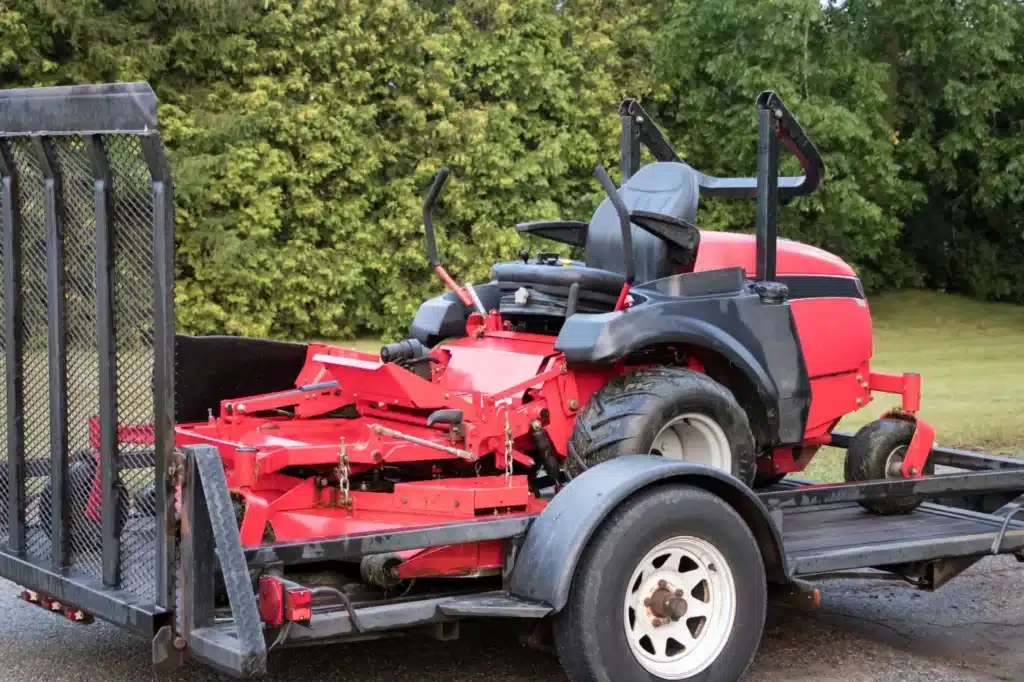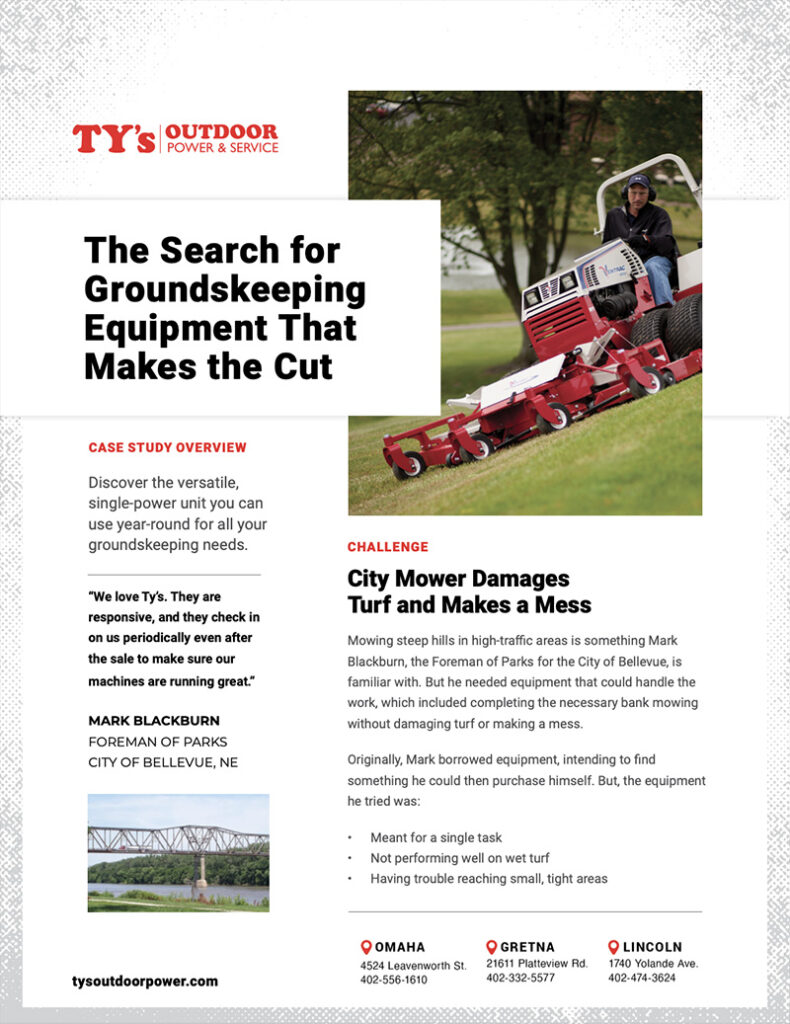Well, football is back on TV, kids are back in school, and Runza is rolling out the chili and cinnamon rolls… so it must be autumn in Nebraska!
As another one of our notoriously unpredictable winters approaches, it’s time to prepare your outdoor power equipment for the cold months ahead. Winterizing your tools helps them last longer and work their best when spring arrives.
Neglecting to winterize your outdoor power equipment can lead to engine problems, rust, and other issues that shorten the lifespan of your tools. By following a few simple steps, you can ensure ol’ faithful stays running for years to come.
Why Winterize Outdoor Power Equipment?
Simply put, cold temperatures can cause damage. For example, gasoline can break down and form gunk, making it hard for your engine to run smoothly next spring. Storing equipment without cleaning it first can lead to rust and corrosion.
Proper maintenance can extend equipment’s life by up to 30%. That’s a big savings in money and time! When you winterize, you protect your tools from harsh weather and ensure they’ll be ready when you need them.
Taking these steps now means less hassle later. It keeps your equipment in great shape for the next season. Remember, a little care goes a long way!
When to Winterize Outdoor Power Equipment
So, you’re committed to winterizing all your outdoor power equipment this year. Great! But when should you get started?
Winterization can start once the summer growing season ends. You should also wait until your fall clean-up is complete. This means you’ve finished tasks like mowing, edging, preparing garden beds for winter, power washing, and trimming bushes.
For those living in Nebraska, the timing can vary. You might not need to winterize until October or November. The weather plays a big part in this decision. A few warm days in September can extend the growing season. As soon as you notice low temperatures consistently in the 40s and frost in the forecast, it’s probably time to prepare your equipment for its long winter nap.
You can take a phased approach to your winterization, too. When you think you’ve done the final task for a specific tool, winterize it that weekend. For example, if you think you’ve made your last pass with the lawn mower but you know you’ll still need your chainsaw to get some tree removal done, go ahead and winterize the mower now and save the chainsaw for later.
Your Outdoor Power Equipment Winterization Checklist
With the whys and the whens out of the way, you may still be wondering what outdoor power needs to be winterized. Here’s a list to get you started:
- Lawn mowers
- Leaf blowers
- String trimmers
- Chainsaws
- Tillers
- Pressure washers
- Other gas-powered garden equipment, like aerators or power rakes.
Now, let’s dive into how to keep each piece of equipment in good shape during the cold season.
Bring equipment inside or cover it up
Storing your outdoor power equipment properly in winter is important for maintaining its condition and preventing rust. If possible, bring your equipment inside. A garage or shed is the best place.
If you can’t store it inside, you need to cover it up. Use a heavy tarp or waterproof cover, making sure it fits snugly. This keeps snow and rain off the equipment. Moisture can lead to corrosion and engine problems! If possible, try to elevate it on a concrete pad or pallet.
Proper storage can extend the life of outdoor equipment by up to 50%.
Start with a deep clean
Moisture is probably your outdoor power equipment’s biggest enemy, but dirt and debris are a close second. Dirt can trap moisture, leading to rust and degradation of other non-metal components.
Some equipment, like lawnmowers, tends to get dirtier than others. Lawnmowers cut grass and the clippings and moisture can create build-up on your mower deck. If you don’t clean the deck out, clippings will dry out and stick. This makes it harder for the mower to tackle your lawn.
Think of a deep clean as an investment. It keeps your gear running smoothly when you need it most. Take the time to scrub away any dirt and grime, then make sure the equipment gets fully dry before covering it. Your equipment will thank you.
Check for damaged parts & replace them now
Now’s a great time to check your outdoor power equipment for damage. Start by inspecting the body of your mower, trimmer, or blower. Look for cracks, rust, or loose parts. Pay attention to the blades, as dull or damaged ones can affect performance.
Next, examine the cords and wires. Frayed or broken cords can be dangerous. Look for any signs of wear on tires or wheels. These often go unnoticed but can lead to bigger problems.
If you’ve noticed anything that needs to be repaired or replaced, it’s important to order replacement parts now. If you wait until spring, you might face long wait times for parts or service. Many parts are back ordered during the busy season, and small-engine shops will be full. Replacing your parts now or getting a complete winterization service from a professional helps you avoid crunch time in the spring.
Don’t forget to deal with the fuel
Draining or stabilizing the fuel in your outdoor power equipment is crucial. Fuel can go stale after sitting for a while, causing engine problems or even damage. By draining or stabilizing the fuel, you help keep your equipment running smoothly.
To drain the fuel, start by turning off the engine. Then, position a container under the fuel tank. Remove the fuel line or drain plug carefully. Let the fuel pour into the container. Make sure to dispose of it properly.
If you want to stabilize the fuel instead, add a fuel stabilizer to the tank. Follow the instructions on the stabilizer’s label. Run the engine for a few minutes. This helps to mix the stabilizer with the fuel. Most stabilizers can keep fuel fresh for up to 12 months.
Change the fuel filter
Knowing when to change a fuel filter is important for your outdoor power equipment. If your engine starts to sputter or if it struggles to start, the fuel filter might be clogged. You may also notice a decrease in power or unstable engine performance. If you haven’t changed it in over a year or after your manufacturer’s recommended number of hours of use, it’s time.
To change the fuel filter, start by turning off your equipment and letting it cool down. Then, disconnect the spark plug wire to avoid accidental starts. Locate the fuel filter, which is usually near the gas tank. Carefully remove the old filter. Make sure to note the direction of the flow. Install the new filter in the same direction. Secure it well, and reconnect the spark plug wire.
Remember to dispose of the old filter properly. Keeping your fuel filter fresh can make your equipment run smoother and last longer.
Maintenance the spark plug
Checking and replacing spark plugs in outdoor power equipment is essential for good performance. If they’re dirty or worn out, the engine may not start, or you may suffer performance issues. A good rule is to check them every season or after every 100 hours of use.
First, you need to find the spark plug. Check your owner’s manual if you’re unsure where it is. You’ll often find it near the engine. Use a wrench to remove the spark plug. Be careful not to damage the threads!
Next, inspect the spark plug. If it looks black and sooty or has cracks, it’s time to replace it.
Before installing the new spark plug, check the gap with a gauge. The gap should match what’s listed in the owner’s manual. Finally, install the new plug and tighten it with a wrench.
Oil or lubricate hinges and moving parts
Keeping hinges and moving parts lubricated is important. When they dry out, they can rust or break. This can lead to squeaks, stiffness, or even failure. A simple oiling routine can keep them working smoothly.
Use a lightweight oil, like machine oil or WD-40. First, clean the area around the hinge or moving part. Remove any dirt or dust. Next, apply a small amount of oil to the joint. Make sure it seeps into the moving parts. Wipe away any excess oil with a cloth.
It’s best to oil these components at least twice a year. A little oil goes a long way in preventing problems!
Winterizing Electric Equipment
Winterizing your electric outdoor power equipment is also important. One benefit of electric outdoor power is that maintenance and winterization are generally easier.
First, you’ll still need to choose a proper, dry storage location for the equipment itself. Then, you’ll need to clean your equipment. Remove dirt and debris from the surfaces. You can use a damp cloth and a soft brush but don’t hose down an electric mower.
You’ll want to give the equipment a once over for damage and check the battery. Make sure you remove the battery from the equipment and store it in a cool, dry place for the winter.
Never store your batteries in a garage or shed without climate control. The most common reason for battery failure is damage caused by fluctuating temperatures. Garages and sheds are too hot for batteries in the summer and too cold in the winter, especially in Nebraska.
Inspect the power cords for any signs of wear or fraying. If you see any damage, replace them. Storing the cords properly will also protect them from being tangled or damaged.
Taking these simple steps can extend the life of your electric outdoor power equipment!
Service now, start spring happy
Properly winterizing your equipment is crucial for a smooth start in spring. When you take the time to prepare your tools and machines, you help them last longer.
It also means less hassle in spring when you want to get back to work on your lawn, garden, and landscape projects. Set yourself up for a successful spring next year by taking these steps now. A little effort in the fall can make a big difference later! If your fall is looking a little too busy to DIY these important steps, Ty’s Outdoor Power is here to help. Check out our options for service. We’ll even pick up and deliver your equipment, ready to store for winter.


